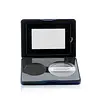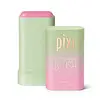What's inside
What's inside
 Key Ingredients
Key Ingredients

 Benefits
Benefits

 Concerns
Concerns

 Ingredients Side-by-side
Ingredients Side-by-side

Caprylic/Capric Triglyceride
MaskingOctyldodecanol
EmollientIsopropyl Myristate
EmollientHelianthus Annuus Seed Oil
EmollientPolybutene
Octyldodecyl Stearoyl Stearate
EmollientPersea Gratissima Oil
Skin ConditioningSynthetic Wax
AbrasiveSynthetic Beeswax
Emulsion StabilisingButyrospermum Parkii Butter
Skin ConditioningSimmondsia Chinensis Seed Oil
EmollientCandelilla Cera
EmollientOzokerite
Emulsion StabilisingRicinus Communis Seed Oil
MaskingTocopheryl Acetate
AntioxidantCopernicia Cerifera Cera
EmollientIsopropyl Alcohol
SolventCitric Acid
BufferingPhenoxyethanol
PreservativeBHT
AntioxidantCI 45410
Cosmetic ColorantCI 77007
Cosmetic ColorantCI 77499
Cosmetic ColorantCaprylic/Capric Triglyceride, Octyldodecanol, Isopropyl Myristate, Helianthus Annuus Seed Oil, Polybutene, Octyldodecyl Stearoyl Stearate, Persea Gratissima Oil, Synthetic Wax, Synthetic Beeswax, Butyrospermum Parkii Butter, Simmondsia Chinensis Seed Oil, Candelilla Cera, Ozokerite, Ricinus Communis Seed Oil, Tocopheryl Acetate, Copernicia Cerifera Cera, Isopropyl Alcohol, Citric Acid, Phenoxyethanol, BHT, CI 45410, CI 77007, CI 77499
Hydrogenated Polyisobutene
EmollientDiisostearyl Malate
EmollientCaprylic/Capric Triglyceride
MaskingSynthetic Wax
AbrasiveBis-Diglyceryl Polyacyladipate-2
EmollientSynthetic Beeswax
Emulsion StabilisingCandelilla Cera
EmollientRicinus Communis Seed Oil
MaskingHydrogenated Castor Oil
EmollientTocopheryl Acetate
AntioxidantGlycerin
HumectantCitric Acid
BufferingAscorbic Acid
AntioxidantAloe Barbadensis Leaf Extract
EmollientCamellia Sinensis Leaf Extract
AntimicrobialCitrus Limon Fruit Extract
MaskingFragaria Chiloensis Fruit Extract
Skin ConditioningHamamelis Virginiana Extract
AntiseborrhoeicPanax Ginseng Root Extract
EmollientPyrus Malus Fruit Extract
Skin ConditioningRubus Idaeus Fruit Extract
AstringentVaccinium Angustifolium Fruit Extract
Skin ProtectingVitis Vinifera Fruit Extract
Skin ConditioningPolyglyceryl-2 Triisostearate
EmulsifyingCeramide AP
Skin Conditioning1,2-Hexanediol
Skin ConditioningPhenoxyethanol
PreservativeCI 77891
Cosmetic ColorantIron Oxides
CI 15850
Cosmetic ColorantCI 45410
Cosmetic ColorantHydrogenated Polyisobutene, Diisostearyl Malate, Caprylic/Capric Triglyceride, Synthetic Wax, Bis-Diglyceryl Polyacyladipate-2, Synthetic Beeswax, Candelilla Cera, Ricinus Communis Seed Oil, Hydrogenated Castor Oil, Tocopheryl Acetate, Glycerin, Citric Acid, Ascorbic Acid, Aloe Barbadensis Leaf Extract, Camellia Sinensis Leaf Extract, Citrus Limon Fruit Extract, Fragaria Chiloensis Fruit Extract, Hamamelis Virginiana Extract, Panax Ginseng Root Extract, Pyrus Malus Fruit Extract, Rubus Idaeus Fruit Extract, Vaccinium Angustifolium Fruit Extract, Vitis Vinifera Fruit Extract, Polyglyceryl-2 Triisostearate, Ceramide AP, 1,2-Hexanediol, Phenoxyethanol, CI 77891, Iron Oxides, CI 15850, CI 45410
 Reviews
Reviews

Ingredients Explained
These ingredients are found in both products.
Ingredients higher up in an ingredient list are typically present in a larger amount.
Candelilla Cera isn't fungal acne safe.
This ingredient is an emollient, solvent, and texture enhancer. It is considered a skin-softener by helping the skin prevent moisture loss.
It helps thicken a product's formula and makes it easier to spread by dissolving clumping compounds.
Caprylic Triglyceride is made by combining glycerin with coconut oil, forming a clear liquid.
While there is an assumption Caprylic Triglyceride can clog pores due to it being derived from coconut oil, there is no research supporting this.
Learn more about Caprylic/Capric TriglycerideCI 45410 is a synthetic red-pigment and dye.
It often goes by both Red 28 or Red 27; manufacturers label both ingredients as CI 45410.
This dye is commonly found in makeup because it imparts a vivid color. Some types of this dye change color based on pH level and interaction with moisture:
Your skin has a natural pH of around 4.5 - 5.5.
According to the FDA, CI 45410 is not permitted for use in eye products.
Red 27 is a flourescein dye and commonly used as a fluorescent tracer in medicine.
Learn more about CI 45410Citric Acid is an alpha hydroxy acid (AHA) naturally found in citrus fruits like oranges, lemons, and limes.
Like other AHAs, citric acid can exfoliate skin by breaking down the bonds that hold dead skin cells together. This helps reveal smoother and brighter skin underneath.
However, this exfoliating effect only happens at high concentrations (20%) which can be hard to find in cosmetic products.
Due to this, citric acid is usually included in small amounts as a pH adjuster. This helps keep products slightly more acidic and compatible with skin's natural pH.
In skincare formulas, citric acid can:
While it can provide some skin benefits, research shows lactic acid and glycolic acid are generally more effective and less irritating exfoliants.
Most citric acid used in skincare today is made by fermenting sugars (usually from molasses). This synthetic version is identical to the natural citrus form but easier to stabilize and use in formulations.
Read more about some other popular AHA's here:
Learn more about Citric AcidPhenoxyethanol is a preservative that has germicide, antimicrobial, and aromatic properties. Studies show that phenoxyethanol can prevent microbial growth. By itself, it has a scent that is similar to that of a rose.
It's often used in formulations along with Caprylyl Glycol to preserve the shelf life of products.
Ricinus Communis Seed Oil is the INCI name for castor oil.
Castor Oil helps moisturize the skin. It is rich in a fatty acid called ricinoleic acid. This fatty acid helps prevent moisture loss on the skin. This helps keep your skin soft and hydrated. Ricinoleic acid also has anti-inflammatory and pain reducing properties.
Besides hydrating the skin, castor oil is also used to hydrate hair. By keeping the hair shaft moisturized, breakage is decreased. More studies are needed to show castor oil's effective on stimulating hair growth.
Castor oil is created by cold-pressing castor seeds and then purifying the oil with heat. It was used in Ancient Egypt as fuel in lamps and to help treat eye irritation.
The term 'fragrance' is not regulated in many countries. In many cases, it is up to the brand to define this term. For instance, many brands choose to label themselves as "fragrance-free" because they are not using synthetic fragrances. However, their products may still contain ingredients such as essential oils that are considered a fragrance.
Learn more about Ricinus Communis Seed OilSynthetic beeswax is created to be identical in structure to beeswax. It possesses the same occlusive and emulsion properties.
A blend of fatty acid esters, fatty acids, and alcohols are used to create synthetic beeswax. Whether or not this ingredient is vegan depends on the source. Sometimes, lanolin is used for its creation.
This ingredient may not be Malassezia folliculitis, or fungal-acne safe.
Learn more about Synthetic BeeswaxSynthetic Wax is created from fossil fuels such as natural gas. It is used to enhance texture, adjust pH, and as an occlusive.
It may also be used as an abrasive ingredient to exfoliate the skin.
Synthetic Wax may not be fungal acne safe.
Learn more about Synthetic WaxTocopheryl Acetate is AKA Vitamin E. It is an antioxidant and protects your skin from free radicals. Free radicals damage the skin by breaking down collagen.
One study found using Tocopheryl Acetate with Vitamin C decreased the number of sunburned cells.
Tocopheryl Acetate is commonly found in both skincare and dietary supplements.
Learn more about Tocopheryl Acetate